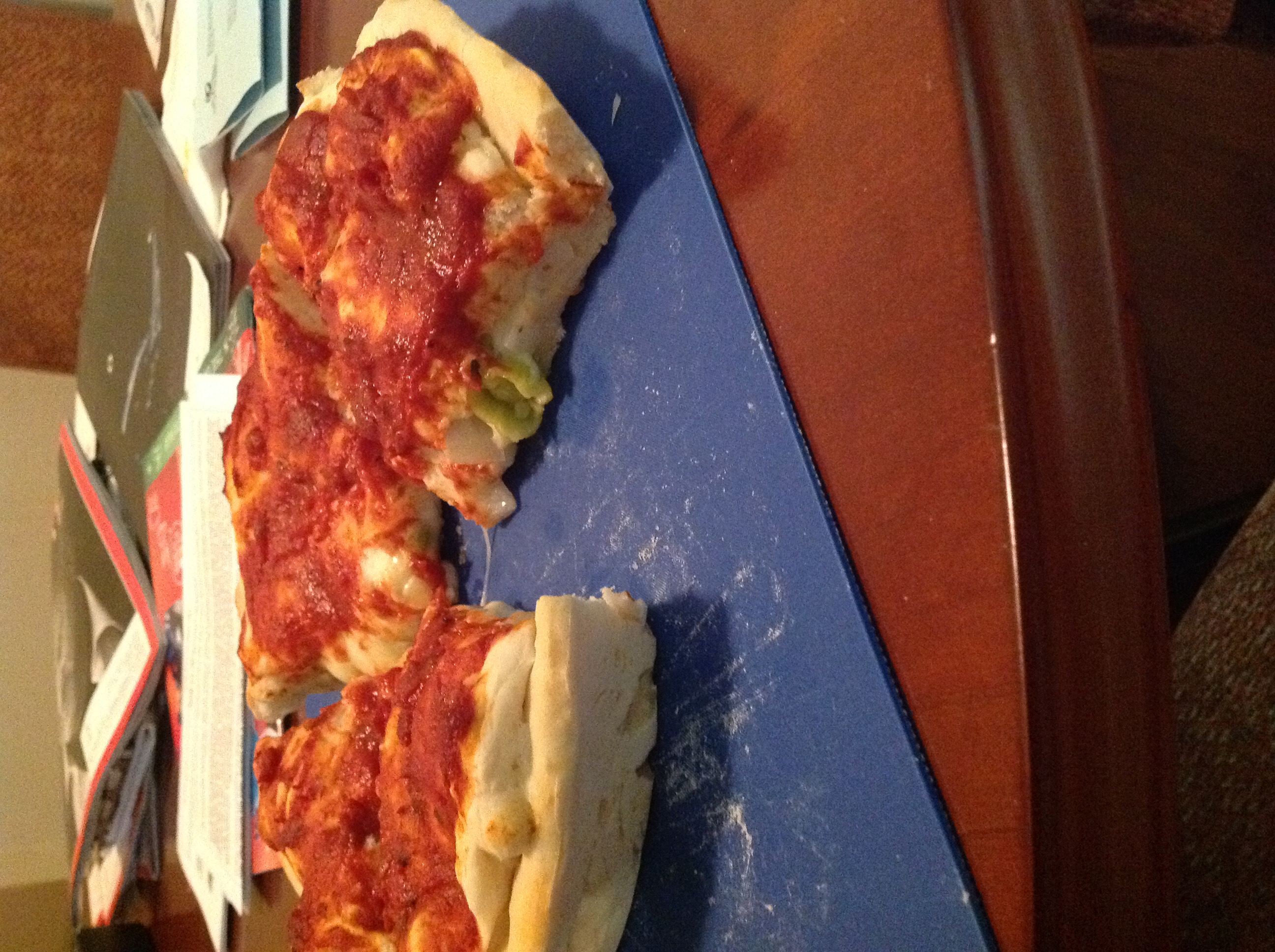I don’t really like food. This is surprising, since being a programmer I get exposed to a variety of foods from around the world, ranging from Greece to the Golden Triangle to America (U.S., Canada, and Central America).
I guess “around the world” actually means “the Northern hemisphere” in this context.
And yes, I recognize that what I eat from restaurants near my workplace hardly counts as authentically from those locations. But I’ll take what I can get.
But that said, I like pizza.
In general, my favorite tends to be deep dish pizzas. Super thin (New York style) pizzas are good as well, but in my opinion don’t stack up as well. My long-time favorite is a Chicago style stuffed crust pizza that comes from Mangia’s in North Austin. Recently I was introduced to the Detroit style of pizza (from Via 313, also from Austin in case you had any doubts about where I lived), which prides itself on being made in automobile parts trays, after the car industry they built the city on. These are both delicious deep dish pizzas.
More modern Detroit style pizzas are baked in an abandoned factory with broken windows and rusty parts trays.
Anyway, since I moved and started shopping for myself it’s become easier to cook for myself beyond just warming up frozen pizza. And I’ve found it’s surprisingly easy to make not terrible pizza from some flour and some sauce and some cheese. So I do that, because it’s good food and it’s cheaper than eating out all the time and maybe also cheaper than eating frozen pizzas, or at least about the same cost. Either way it’s tastier (though nobody other than I has taste-tested my cooking, so I could be lying). But, these are simple single-layer pizzas, and I do miss the taste of more complicated pizzas.
So, I took on the challenge of making a stuffed crust pizza. This is my recipe and my results, put in terms a non-chef would understand.
Note: Here one pizza is enough for two people, i.e. suitable for you and a hot date or (more likely) you and future you looking for leftovers. It is assumed neither you nor your hot date are professional pizza-eating-contest-contestants. If so, double the recipe.
Also worth noting is this recipe is currently in early development, I find it to be very doughy. You may want to halve the amount of dough used. I will update as I see fit.
Step 1: The Dough
The result of this step: Two covered bowls full of risen dough. (rised bread? It’s not bread unless you bake it, though)
This part is surprisingly easy, especially if you grew up around bread machines. I had always assumed that bread machines were really important for all things yeast.
And they are. Just not for pizza. You don’t need a bread machine, just a bowl and a willingness to make a mess.
Here’s a list of tools you will need:
- A mixing bowl, ideally approximately one forearm’s diameter.
- A 1 cup measuring cup (and a knife with a flat edge).
- A 1 tablespoon measure.
- A 1 teaspoon measure.
- A big spoon for mixing.
- 2 bowls.
- Plastic wrap.
- Thermometer to determine water temperature. (though you don’t have to be very exact)
Here’s the list of ingredients:
- 3 cups flour. I buy it 5lbs at a time of the store brand, because that’s cheapest.
- 1 tablespoon of sugar.
- 1 teaspoon of salt. The one with the little girl with the umbrella is fine.
- 1 packet of yeast. Most recipes say “1⁄4 cup of yeast,” but it’s sold in 1⁄4 cup packets, so just get a packet (actually it’s sold in sets of three 1⁄4 cup packets).
- Heatable water. None of that ice-nine stuff.
Here’s the procedure (read before doing!):
- Pour 3 cups of flour into your mixing bowl. To do this you can scoop a heaping pile of flour, then use the back of a knife to scrape the heap back into the bag. Measuring cups measure to the brim.
- Pour 1 tablespoon of sugar into the mixing bowl.
- Pour 1 teaspoon of salt into the mixing bowl.
- Take a packet of yeast, and cut the corner off. Empty the contents into the bowl.
- Mix the dry goods.
- Fill your cup measure with warm (110 degree) water. You can do this using a thermometer for the first few times. I found it’s approximately between “warm” and “hot” water. If the temperature isn’t exact, that’s fine - I’ve never had dough fail to rise because the water was too warm. Remember that a thermometer will take some time to heat up.
- As soon as you poured the water in, take your big spoon and start mixing. The goal is to get the dry goods to mix with the water. Generally at the beginning (first few seconds) I will push the dry goods to the edges of the bowl, into the water, with my spoon. Then I will scrape along the sides of the bowl toward me, and then squish the spoon through the middle of the bowl to the far side (in a sort of pressing motion).
- After a minute or so, the dough should start to pull together into small strandy dough-like bits. You should be able to reach in with your hands and smoosh all of the dough together. Some bits will fall off, that’s fine. Sometimes if they’re big you can stick them back on. Gather all of the bits you can reasonably hold.
- Now knead the dough. Press it like you’re giving someone a massage, except you can physically push your hands through them and they are a ball of dough. I keep it suspended in the air over the bowl. Squeeze it, then fold it back into a ball shape and squeeze it again. The goal is to mix it even better, I guess. Do this until your hands get tired and the floury dough has magically turned into sticky homogenous not-floury dough.
- Split the dough in two, place each into a bowl, and cover each bowl with some sort of plastic wrap.
- Place each bowl on top of a computer running Tensorflow or other heavy computation (at least 300W with heavy CPU and GPU utilization is ideal). A webserver may be fine as well. (but seriously, the temperature should be at least 78 degrees and ideally 80 degrees for the bread to rise. This can be a problem if you like your apartment cold. 74 degrees is too cold)
Step 2: The Toppings
The result of this step: The toppings I used when I made this post (onions and peppercini).
You can do this step concurrently with the next step if you wish. This is mostly just a placeholder step so that you remember to make toppings, which involves buying them and buying the tools you need.
Here’s a list of tools you will need:
- Sharp knife.
- Cutting board. I use one of those small flexible non-stick ones I found at a grocery store.
- Bowl. Or, somewhere to put the ingredients before you put them on a pizza.
Here’s a list of ingredients:
- Peppercini peppers (pronounced “pepper-ch-eeny”). Not the similar-looking but different banana peppers. If you have to buy a bunch of pizzas from Papa John’s just for the peppers, do it. You will need approximately 3 peppers for a whole pizza, adjust to your liking.
- An onion.
Here’s the procedure (Read before doing!):
- Cut a thick (1⁄2”) slice of onion. Remove center, cut onion slice into quarters. Set aside. (note: This actually produces much more onion than is probably ideal, if you’re doing something else that requires half an onion slice then go for it)
- Chop peppercinis into ~3⁄8” slices. You should get ~4 slices out of each pepper. Set aside.
Step 3: The Pizza
The result of this step: A stuffed crust pizza.
Here’s a list of tools you will need:
- Cutting board
- Pizza cutter
- Rolling pin
- Pie pan (Mine is 8” in diameter and 1 1⁄4” tall, taller would work but I wouldn’t go shorter)
- Cookie sheet (note: This is just to roll the dough out onto)
- Spoon (for spreading sauce)
- 1 tablespoon measure.
- Oven mitt.
Here’s a list of ingredients:
- Dough (both bowls of dough from Step 1 - this is a two-dough recipe)
- Toppings (from Step 2)
- 1 tablespoon of olive oil.
- Mozzarella cheese. So much mozzarella. On the order of 8-12 ounces of mozzarella. I buy the pre-shredded variety that comes in bags at the grocery store.
- Pizza sauce. This part is being a little finicky with me, you can make your own or you can buy a jar of pizza sauce from the store. It doesn’t provide a majority of the taste.
Here’s the procedure (Read before doing!):
- Preheat oven to 450 degrees Fahrenheit.
- Roll out 1 pizza dough. It should be about 1⁄4” thick.
- Roll out the other pizza dough. It should also be about 1⁄4” thick.
- Spread dough in pie pan. Be careful to press the dough into the corners of the pan. The dough should lie along the bottom of the pan and up to the rim. It may overhang the rim of the pan if you want.
- Pour 1 tablespoon of oil onto the dough (not more! Even if you’re tempted). Then spread it around with the back of a spoon (or similar) until it evenly coats the dough.
- Place the pizza in a 450 degree oven for 5 minutes to toast the lower crust.
- Remove pizza. Place a layer of cheese on the pizza. The layer should be at least 1⁄2” thick, consisting of several handfuls of cheese. This layer uses half of the cheese on the pizza.
- Place toppings on the cheese layer.
- Place the second layer of cheese. This layer should be about the same size as the first layer, and should come to the rim of the pie pan.
- Place pizza in a 375 degree oven for 5 minutes to let the cheese melt. Remove pizza.
- Add the second crust to the top of the cheese layer. Tear off any pieces of dough that go outside the pie pan. Note that, because of the cheese, this dough may end up well above the rim of the pie pan. Pinch this layer of dough to the edge of the first layer of dough, so that the cheese and toppings have nowhere to escape to. Warning: The pie pan may be hot.
- Place pizza in a 375 degree oven for 15 minutes.
- Remove pizza onto cutting board. Cut into slices. Consume pizza as desired. Note that the pizza may be messy, so don’t eat it in a bathtub full of cash.

Someday I’ll fix the image rotations, I promise.
So, there you have it, that’s my current recipe. Here’s the fine print: It’s honestly not all that great, both times I’ve made it it turned out to be extremely doughy (as in, the pizza was more loaf of bread with cheese in it than cheese with crust around it). I suspect this is because I use two doughs, I intend to try using one dough and splitting it in two for top and bottom. I will update this recipe as I see fit.
Comment below with your questions and results! Actually, don’t, except as a last resort. If you’re reading this you probably either a) can contact me directly or b) can contact me through somebody who knows me directly.
